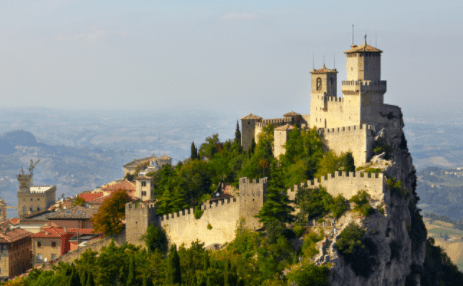Located on the northeastern side of the Apennine Mountains, San Marino covers a land area of just over 61 km2 (24 sq mi) and has a population of 33,562. Its capital is the City of San Marino and its largest settlement is Dogana. The capital is set at the highest point of the country on a steep mountain. San Marino’s official language is Italian, although Romagnol is the historical language and still in existence in a non-official capacity.
The country derives its name from Saint Marinus, a stonemason from the then Roman island of Rab, in modern-day Croatia. Born in AD 275, Marinus participated in the reconstruction of Rimini’s city walls after their destruction by Liburnian pirates. Marinus then went on to found an independent monastic community on Monte Titano in AD 301; thus, San Marino lays claim to being the oldest extant sovereign state, as well as the oldest constitutional republic.
San Marino’s politics are ruled by its constitution, which dictates that every six months San Marino’s parliament must elect two Captains Regent. The Captains Regent have equal powers and are free to exercise them within the limits of the constitution and parliamentary legislation until their term expires.
The country’s economy is mainly based on finance, industry, services, and tourism. It is one of the wealthiest countries in the world in terms of GDP per capita, with a figure comparable to the most developed European regions. San Marino is considered to have a highly stable economy, with one of the lowest unemployment rates in Europe, no national debt, and a budget surplus.
Religion
San Marino is a predominantly Catholic state —over 97% of the population profess the Roman Catholic faith, but Catholicism is not an established religion. Approximately half of those who profess to be Catholic practice the faith. There is no episcopal see in San Marino, although its name is part of the present diocesan title. Historically, the various parishes in San Marino were divided between two Italian dioceses, mostly in the Diocese of Montefeltro, and partly in the Diocese of Rimini. In 1977, the border between Montefeltro and Rimini was readjusted so that all of San Marino fell within the diocese of Montefeltro. The bishop of Montefeltro-San Marino resides in Pennabilli, in Italy’s province of Pesaro e Urbino.
There is a provision under the income tax rules that the taxpayers have the right to request for allocation of 0.3% of their income tax to the Catholic Church or to charities. The churches include the two religious groups of the Waldensian Church and Jehovah’s Witnesses.
The Roman Catholic Diocese of San Marino-Montefeltro was until 1977 the historic diocese of Montefeltro. It is a suffragan of the archdiocese of Ravenna-Cervia. The diocese includes all the parishes of San Marino. The earliest mention of Montefeltro, as Mona Feretri, is in the diplomas by which Charlemagne confirmed the donation of Pepin. The first known bishop of Montefeltro was Agatho (826), whose residence was at San Leo. Under Bishop Flaminios Dondi (1724) the see was again transferred to San Leo, but later it returned to Pennabilli. The historic diocese was a suffragan of the archdiocese of Urbino. Since 1988, there is formally an apostolic nunciature to the republic, but it is vested in the nuncio to Italy.
There has been a Jewish presence in San Marino for at least 600 years. The first mention of Jews in San Marino dates to the late 14th century, in official documents recording the business transactions of Jews. There are many documents throughout the 15th to 17th centuries describing Jewish dealings and verifying the presence of a Jewish community in San Marino. Jews were permitted official protection by the government.
During World War II, San Marino provided a haven for more than 100,000 Jews and other Italians (approximately 10 times the Sammarinese population at the time) from Nazi persecution. As of 2012, few Jews remain. In 2019 it has been inaugurated the ‘Chapel of three religions’, the first-ever building of its kind devoted to interfaith dialogue.

